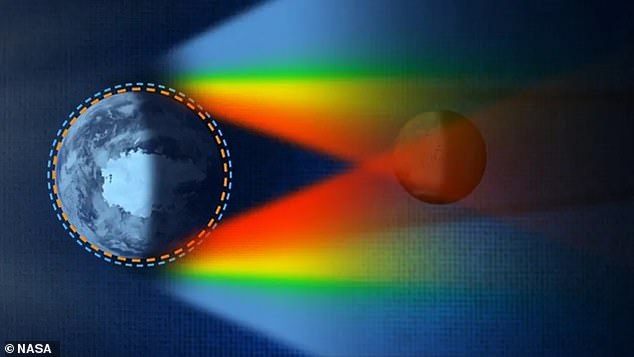Super ‘blood moon’ heralds spooky season – here’s how to see celestial events
A super harvest blood moon will light up the night sky on Tuesday, just in time for the spooky season.
The harvest season full moon occurs every year in September, but it occurs while the moon is at perigee, or the point at which the moon is closest to the Earth.
That means this Harvest Moon will be a supermoon, appearing up to 14 percent larger than a regular full moon.
And in an extra-spooky twist, it will also be a blood moon. These only occur during a lunar eclipse and bathe the moon in red light.
Like supermoons, blood moons occur a few times a year, but rarely at the same time.
On Tuesday, a super harvest blood moon will light up the night sky, appearing larger than normal and tinged with red – a spooky sight to kick off the spooky season
This is the second of four consecutive supermoons that will be visible in the sky through November.
It will be visible on Tuesday evening, September 17th and Wednesday morning, September 18th.
For US stargazers, the super blood moon will appear in the eastern sky around 7:50 p.m. on the East Coast and around 7:10 p.m. on the West Coast.
The lunar eclipse, when the moon appears red in color, will take place on Tuesday evening.
On the East Coast, the storm will begin around 8:41 p.m., peak at 10:44 p.m., and end at 12:47 a.m.
On the West Coast, the storm begins at 7:12 PM, reaches its maximum at 10:44 PM, and ends at 12:47 AM.
During the eclipse, you won’t see the entire moon disappear behind the Earth’s shadow. Instead, you’ll see a piece of it disappear briefly before coming back into view.
That’s because only that small portion is obscured by Earth’s “umbra,” or the darkest part of our planet’s shadow.
“Apart from the small dark area at the top of the lunar disk, most of the visible lunar disk will be in Earth’s penumbra, the lighter part of the planet’s shadow that does not completely block sunlight,” said astrophysicist Teresa Monsue of NASA’s Goddard Space Flight Center. NPR.

During a lunar eclipse, the Sun’s light is filtered by the Earth’s atmosphere, causing the Moon’s surface to appear red
But even this small overlap between the Moon and the Earth’s shadow is enough to change the way we perceive the color of the lunar surface.
During a lunar eclipse, the Earth passes between the sun and the moon. This partially blocks the sunlight from reaching the lunar surface, but some light still slips through.
Those photons have to pass through the Earth’s atmosphere to light up the moon. The atmosphere acts as a filter, scattering blue light but allowing longer wavelengths of red, yellow and orange light to pass through.
This gives the moon the reddish-brown appearance we call a ‘blood moon’.
Individually, a harvest moon, a supermoon, and a blood moon are not particularly rare or unusual events. They occur every year. But it is rare for all three to occur in a single full moon.
The next time this happens won’t be until September 2033. After that, it won’t happen again until 2042.
